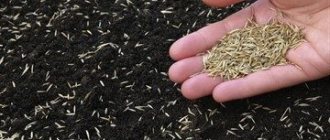When is it better to plant: autumn or spring? comparison table
You can plant lawn grass in autumn or spring. Some varieties are suitable for sowing in summer.
| Advantages | Flaws | |
| Spring |
|
|
| Autumn |
| Possible frosts |
Spring is considered a more suitable time for sowing grass, since in the natural environment it is at this time that greenery begins to grow.
April is best for planting, since at this time the ground has a sufficient supply of moisture after winter snow. If you start planting in May, you should ensure regular and intensive watering. March is a dangerous month, as in some regions there may be severe frosts at this time, which will destroy the first shoots.
How to prepare the soil for planting?
You can’t just buy grass seeds and plant them on your property. The soil for the future lawn must be well prepared so that the seeds take root and produce abundant seedlings:
- It is necessary to remove any debris from the area of the future lawn. Some gardeners do not remove natural debris - stones, branches, fallen leaves - but bury them for a “natural ecosystem”. This is a big mistake. Rubbish should be removed from the site.
- Uproot old stumps, if any. They will not decorate your future lawn, and large and coarse stump roots will prevent the lawn's root system from developing.
- Treat the area with herbicides to remove weeds.
- Dig up the area of the future lawn. At the same time, create a drainage layer of their crushed stone and apply organic fertilizers.
- Carefully level the soil surface. There should be no humps or depressions on the lawn, otherwise the water will be distributed unevenly, which will lead to damping off in some places and yellowing in others.
- Compact the soil with a roller and then loosen the top layer of soil with a rake.
Only after completing all these manipulations will the soil on your site be ready to receive grass seeds. Neglecting any of these steps may result in uneven seed germination. But immediately after completing the work, you can’t sow grass either. The prepared area should be left fallow for one to two months. It is recommended to devote this time to studying the characteristics of lawn grasses and drawing up a suitable grass mixture for your site, taking into account its agrotechnical features.
Sowing dates by region
For sowing, you need to choose a time when the snow has already melted, but the soil remains well moistened. Depending on the region, sowing dates may vary.
| Region name | Deadlines |
| Southern regions of Russia | Beginning or end of March |
| Middle lane | Beginning or end of April |
| Ural and Siberia | End of April - beginning of May |
| Northwestern region | Beginning of May |
Some gardeners rely on lunar calendar dates when planting with their own hands. On these days, the chance of getting a beautiful green lawn is slightly higher than on others. The best dates according to the lunar calendar 2022:
- March 15th;
- 11 April;
- May 8, 17.
Planting seeds for the future lawn
This stage is one of the most important; proper planting largely determines the appearance of the future lawn. For planting work you need to prepare:
- Seeds of selected herbs;
- Mineral fertilizers;
- Tape for measuring territory;
- Garden rake;
- Watering can or hose with spray nozzle;
- Seed spreader (you can do without it).
On the day chosen for planting the lawn, the weather should be dry and calm so that the seeds are not flooded with water or blown away by gusts of wind. Before sowing, it is necessary to apply mineral fertilizers and loosen the soil again with a garden rake.
In some gardening magazines you can find advice to mix grass seeds with sand when planting. However, we do not recommend doing this. You can take more sand than necessary, and it will prevent the seeds from germinating.
For uniform sowing, you can use a special seeder, but it is theoretically possible to achieve uniform sowing manually. To do this, scatter half the seeds in one direction, and the other half in a direction perpendicular to it.
After sowing is complete, take the garden rake again and very gently mix the soil with the seeds. Ideally, all the seeds should go 2-3 mm into the soil, but in practice some of them will remain on the surface. Water your crops carefully.
If everything is done correctly, you will see the first shoots in 1-2 weeks. Throughout this time, it is necessary to water the crops every day so that the soil does not become dry. But at the same time, make sure that the water does not erode the ground.
What type of grass is best to use?
You can immediately choose ready-made herbal mixtures at a garden store. Among these mixtures are:
- sports - suitable for landing on a football field;
- universal - suitable for any lawn, but require frequent mowing;
- frost-resistant - used for planting in cold regions;
- elite - require certain conditions of maintenance, but look very stylish;
- meadow - these varieties will turn the lawn into a small meadow with various splashes of flowers.
For the Russian climate, you can choose not mixtures, but individual herbs that will look great on your house or summer cottage.
Bluegrass
Bluegrass is a perennial herb that is used as a base for grass mixtures. The grass is easy to care for and has good germination.
Polevitsa
This type of grass grows thickly and leaves no empty spaces on the lawn. Bentgrass has a rich green color and is resistant to frost and frequent cutting.
Ryegrass
This herb goes well with cereals. Despite the fact that ryegrass can be used to create an excellent decorative lawn, it does not tolerate frost well, so it is mainly used in the southern regions. The variety does not require pruning and is often found in elite grass mixtures.
Types of lawns and lawns
Lawns are divided into the following types according to the method of construction:
- Artificial . It does not need to be sown, mowed, watered, or fertilized. It will delight you with bright greenery in winter and summer. Still, this is more of a “cinematic” version.
- Rolled . Such a lawn is a real solution for business people. You can get a beautiful lawn quickly – in one day. The only preliminary work is leveling the ground.
- Seeded . He causes the most trouble. But this is the cheapest option. The main thing is to choose the right species composition of herbs, follow the planting technology and not make mistakes with the time of sowing the seeds.
Seeding tools and step-by-step instructions
To get a perfect lawn, you need to be patient and have the right tools.
Planting Tools:
- rake;
- shovel;
- manual roller;
- root extractor;
- pitchfork;
- watering can.
Before planting, it is necessary to prepare the area for planting grass.
Soil preparation
The ground must be leveled and excess bumps or holes removed. To do this, use a shovel and a rake. The soil should be loosened so that air can pass to the roots of the plants.
Use a soil mixture that meets the following requirements as soil:
- pH: 5.5–6.5;
- humus: from 2.5 to 3.5%;
- nitrogen and its compounds: 10 mg per 100 g of soil;
- phosphorus: 15–25 mg per 100 g of soil;
- potassium: 20–30 mg per 100 g of soil;
- microelements: control of copper and zinc content.
Sand must be added to the soil to make it looser.
Tamping
To keep the lawn level, you need to compact the soil. The procedure is performed using a garden roller. If there is no such device, then the soil can be slightly moistened and trampled with your feet. Shoe marks can be removed with a rake.
If voids are formed during compaction, they should be filled with new soil.
Pre-sowing preparation
Before planting seeds, it is important to carry out the following activities:
- A week in advance, scatter mineral fertilizer throughout the prepared soil.
- Loosen the soil so that minerals penetrate deep into the soil.
- A day before, walk the rake over the ground again so that no large lumps remain.
After this, you can start sowing grass.
Step-by-step instructions for sowing lawn grass
If a mixture of grasses is used, the seeds must be mixed well before planting to ensure a beautiful lawn.
- Divide the total number of seeds into 4 parts.
- Sow 1 part of seed per 1/4 of the lawn.
- Sow seeds in different directions (along and across the grooves that remain after loosening).
- Walk across the lawn with a fan rake without stepping on the ground.
If the soil is wet, then watering is not required; if it is dry, then the seeds should be carefully watered using a watering can or drip irrigation system.
Sowing a lawn with your own hands in spring step by step
Sowing a lawn in the spring with your own hands is a rather labor-intensive task. In addition to the physical effort and free time spent, a lawn will require material investments. If everything is done correctly, soon after planting a carpet of grass will grow in front of the house without bald spots, holes, protrusions and other defects.
Selection of seed
At this stage, it is worth paying attention to the nature of the soil (clayey, sandy), climatic conditions, and expected load.
If you are afraid of doing something wrong, we advise you not to search for information on the Internet, but simply read everything in one place, where about grass mixtures and planting, as well as further lawn care, everything is explained consistently and, as they say, “at your fingertips.” . Our editors have launched the book LAWN WITH YOUR OWN HANDS, in which everything is written in simple language, if you are interested, then read on>>>
Grass mixtures most often include meadow bluegrass, perennial ryegrass, bentgrass, and red fescue.
Bluegrass is popular among gardeners living in the northern regions. This is due to its unpretentiousness and resistance to sudden temperature changes. Peak growth occurs 3-4 years after planting in the ground.
The shoot-forming bentgrass has a powerful root system. The plant can reach a height of 15 cm. If the lawn is well cared for, the shade of the grass turns out to be dark green. The bentgrass needs light and plenty of watering. It is quite resistant to trampling.
Red fescue quickly covers the area allocated for lawn. Landscape designers value it very much for this quality. The plant tolerates insufficient humidity, partial shade and low temperatures.
Perennial ryegrass is often called chaff. The culture is distinguished by its survivability, resistance to external influences, and unpretentiousness. Requires minimal care.
Tools
You will need a shovel, a turf removal machine, a grass seeder, a fan rake, a garden roller, and a sprayer for a watering hose (for watering, the usual watering can in this case will not bring the desired effect). In addition to seeds, you need to purchase vermicompost or a ready-made mixture for fertilizing the lawn.
Source: www.obi.ru
Choosing a site for a lawn
There should be no holes, potholes or bumps on the surface of the selected area. They can cause serious problems in the future.
If there is no flat horizontal area available, preference should be given to a gentle slope. In the absence of such an opportunity, you will have to look for an original way out of the situation. For example, turning defects into decorative elements.
Before you start preparing the soil, you need to make a plan for the future lawn. It should mark all existing structures, fences, curbs, pipes, communications. To avoid problems during mowing, you need to leave a certain gap between the fence and the lawn.
Preparing the area
Preparatory work must be carried out in stages. The procedure is as follows:
- The area is cleared of debris and dry leaves.
- The stumps are uprooted, the resulting holes are filled up, and the mounds are “cut off.”
- Remove the turf (the width of the layer is no more than 10 cm).
- Soil is filled in its place, herbicides and complex fertilizers are applied. The latter are selected based on the type of soil. If necessary, drainage is done.
- The area is compacted using a garden roller. Instead, you can use a metal pipe or a processed log.
Planting a lawn in spring
Before sowing, the grass mixture must be thoroughly mixed. Its consumption per 1 sq.m. indicated on the packaging. Then you need to follow fairly simple instructions:
- Use a fan rake to make shallow furrows.
- Evenly distribute the planting material.
- Walk through the “field” with a rake.
- Roll the treated area using a roller or other suitable tools.
- Carefully water and cover the future lawn.
Seeds should be planted in warm, dry weather. The same applies to laying rolled lawn. This option is considered the simplest, but most expensive. The main thing is that the soil is properly prepared and the strips are tightly fitted to each other. Otherwise, the appearance of bald spots cannot be avoided.
Planting a lawn in the spring is not an activity for the lazy. In order for the result to meet expectations, it is necessary to strictly follow the recommendations.
Care after landing
The first shoots will appear in 7-10 days. At this time, you need to monitor the soil moisture and, if necessary, water the lawn every 2-3 days. If it rains, no watering is needed.
In spring, the lawn needs the following care:
- cleaning up debris;
- combing with a fan rake;
- treatment for fungi if necessary;
- reseeding areas that were left bare (the grass might not sprout).
The first lawn mowing is carried out when the grass reaches 8-10 cm.
With proper care, the lawn will be beautiful and green throughout the entire summer season. Regular weeding will help get rid of weeds. If the grass turns yellow due to drought, you should install a drip, automatic irrigation system.
Preparation of grass mixture
It is very rare to see a perfectly smooth and bright green monolawn - that is, a lawn on which only one type of lawn grass grows. Much more often, grass mixtures compiled according to certain rules are used for sowing plots in Kazan. When choosing varieties for planting on a site, the following factors must be taken into account:
- Soil type and composition;
- Average temperatures throughout the year;
- Light level;
- Degree of soil moisture;
- Purpose of the lawn.
Only an experienced specialist with an agrotechnical education can competently analyze all the factors and create the optimal grass mixture for a specific site in Kazan. Without professional knowledge, choosing a herbal composition for planting is quite difficult. You may find the final result of growing your lawn to be disappointing.
How to sow lawn grass
Seed consumption is indicated on the packaging by the manufacturer, but this information is relevant for autumn planting. In summer and spring, the figure increases by 1.5 times, this is due to the washing away of planting material by floods and the destructive effects of heat. Also, the norm is slightly exceeded when planting on slopes.
It is important to distribute the seeds evenly to avoid excessive density and bald patches. The optimal device would be a specially designed seeder, but if you don’t have one, you don’t need to purchase one. Sufficient uniformity can also be achieved by performing the task manually: the seeds are mixed with fine sand in a ratio of 1 to 1. You can also create a homemade seeder from a tin can, in the lower part of which many small holes are made.
Sowing is carried out according to the same scheme that was used for grain sowing in the old days. The first penetration is carried out along the site, the second - across. Then the soil is loosened with a fan rake and compacted with a roller. On narrow strips, tamping is done using a wooden plank, which is placed flat on the ground and pressed down with your feet.
Rules for caring for a seeded lawn
- The optimal height for lawn grass is 6-8 cm, so mow your lawn regularly. This height prevents the proliferation of insect pests and weeds, and the green lawn looks beautiful and neat.
- Water your lawn deeply, but no more than once a week. Too much water promotes grass diseases and also erodes the soil. Don't forget to fertilize your grass.
- Loosen the soil regularly, it is especially important to do this in the fall. Packed soil prevents water, air and fertilizer from reaching the grass roots.
- If you find yourself taking shortcuts across your lawn too often, consider installing a garden path or paving stones in that area. It is worth understanding the difference between a “natural” path in landscape design and a trampled lawn.
- Check the health of your grass regularly to catch pests and diseases early.
When should you sow?
The main seasons for sowing lawn grass are spring and autumn.
Each season has its own characteristics , which should not be neglected, so that the work is not in vain and the area is covered with a thick green grass carpet.
When sowing in autumn, work begins from mid-August to mid-September - this applies to the central zone of the Russian Federation. In other regions, timing may vary. Spring sowing work is carried out from late April to early June.
In exceptional cases, you can plant a lawn in the summer, but you will have to spend more effort to ensure good seedlings.
Site selection and preparation
A suitable place for a lawn is a flat horizontal area or a gentle slope. A slight slope is even better - rain and melt water will not stagnate. You can achieve the desired result in the shade and in the sun, with a substrate of any quality, with the exception of an outright swamp. Disadvantages such as acid-base reaction of the soil, excessively light or heavy soil are leveled out during the soil preparation process by adding additional ingredients. Regarding light deficiency, there are herbs such as:
- fescue (tolerates low light, prefers a dry, light substrate with an acidic reaction);
- red fescue (tolerates partial shade, frost and lack of moisture in the soil);
- bluegrass (undemanding to light and quality of substrate, grows successfully in soil prone to stagnant water);
- perennial ryegrass (maximally shade-tolerant, but does not tolerate drought and extreme cold).
A lawn in the shade even has an advantage - it grows slower than in the sun, and you need to mow the grass less often.
You can choose lawn grasses that will feel comfortable in different weather conditions and have different requirements for the quality of the substrate
Video: choosing lawn grass
Think over the layout in advance; it’s even better to draw a plan for the lawn. There may be some structures on the selected site. All this will interfere with the haircut in the future. If you plan to use a lawn mower rather than a trimmer, there should be at least a meter of free space between the lawn and any wall or fence. A large mower will not allow you to cut grass that is close to the fence efficiently and evenly.
Grass has a tendency to spread throughout the area and “choke” any plantings. If there are flower beds, alpine slides, rose gardens, or other landscape design elements near the lawn, use plastic border strips dug into the soil, which will prevent greenery from spreading uncontrollably.
Flowerbeds with the most valuable and rare flowers must be separated from the lawn so that the grass does not “smother” them
Grass surrounding trees and large bushes often causes deepening of the root collar. This provokes its ripening and the development of rot. If possible, plant trees at the same time as grass, forming small mounds for them so that the root collar is higher above ground level, and installing borders.
Lawn grass can cause the death of shrubs and trees,
If the area is heavily overgrown with weeds, the use of herbicides is recommended to control them. Weeding by hand is useless - the roots of the plants remain in the ground. Dandelions and wheatgrass are especially tenacious.
Roundup is one of the most popular herbicides among gardeners; it must be used strictly according to the instructions
Next, you need to clean and level the selected area. It is necessary to remove all debris, uproot stumps, remove a layer of turf about 10 cm thick, using a shovel or a special machine. Turf is the surface layer of soil in which most of the weed roots are concentrated. Instead of the removed turf, a layer of soil is poured flush with the surface of the earth.
Typical mistakes when landscaping a site
Why is it that not everyone succeeds in growing a beautiful lawn? Let's look at the main reasons:
- Incorrect selection of seeds. Often the significance of this issue is neglected and lawn grass is bought, like from a neighbor or from an advertisement, without going into the specifics of the topography, soil, location of the lawn, and climatic conditions. A grass mixture may have excellent characteristics, but simply not be suitable for your area.
- Haste in preparing the site, especially when leveling it. It is important to perform all actions in the correct sequence. After leveling the area under the lawn for the first time, be sure to let the soil stand, and then repeat the procedure to identify and eliminate possible unevenness after the soil settles.
- Lack of drainage system. Excess moisture is just as detrimental to the lawn, as is its lack. Therefore, special attention should be paid to the composition of the soil. If clay or black soil predominates in it, it is necessary to ensure unhindered outflow of water. Otherwise, you will have to constantly fight against mold, moss and bald spots.
- Uneven grass seeding. At this stage, too, you can’t rush. It’s better to spend a few extra hours when planting than to spend the entire summer here and there filling empty spaces.
An easy way to plant and grow as quickly as possible
In order to grow lawn grass as quickly as possible, you need to choose a suitable grass mixture. Fast growing of grass is guaranteed by a mixture of three herbs:
- 60% ryegrass;
- 20% red fescue;
- 20% meadow fescue.
For rapid germination of grass, the soil must be enriched with mineral fertilizers with a high content of potassium and phosphorus , which should be evenly distributed throughout the area. If the soil is sandy, then adding peat to it will help speed up the growth of grass, and if it is loam, then adding sand to it. The added components should be thoroughly mixed with the main soil while digging the area.
The area should be sown in a cross pattern and the soil moisture should be maintained in the first days after sowing.
What to do immediately after sowing
Planting seeds is not enough; they need to be covered with a rake and compacted moderately with a roller. Every day, the area should receive sufficient moisture. Water evenly. It will take about 20 days before green vegetation begins to emerge in the area.
It is important to take your time stepping onto the lawn and enjoy the work done. Please be patient for another 14 days. Upon completion, you will be able to evaluate what you have done, not only visually, but also by touch.
After sowing, you need to be patient.
Sowing seeds in dry soil is a mistake. Because germination will either drag on for a long time, or it will be completely absent and all the work will be in vain. It is important not to skip the step of performing good drainage. The area should be watered and if the drainage is well done, there is no need to be afraid of overfilling the water. This is especially important during the summer dry season. Consider the fact that young plants are especially sensitive to changes in moisture.
The period of growth and development requires additional feeding with fertilizers. All processes that will be carried out on the grass: rolling. Trimming, etc., damages the plants. They need funds to recover. To get a quick visible effect, use organic and mineral fertilizers.
The grass needs additional fertilizers.











